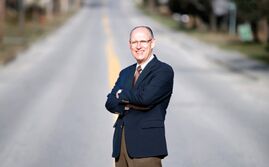New east-west highway proposal renews an old debate with refocused financing
It seems simple: The shortest distance between two points is a straight line. But over the years, creating a line connecting Down East Maine/Canadian Maritimes to lucrative markets in Canada or the Midwest has proved elusive.
Numerous studies have looked into the costs and benefits of building an east-west highway that would eliminate the need for truckers and tourists to either travel south in order to go west, or in the case of Canadian truckers, north around the state's border.
Recently, Peter Vigue, chairman and CEO of Cianbro, has emerged at the forefront of these efforts, saying previously studied routes were too complicated, too expensive and relied on a dwindling supply of highway dollars. Now he's marshaling forces to bring private money and private management to the table.
Since the 1960s, the predominant proposed route for an east-west highway, Vigue says, was Calais to Bangor, down I-95 to Newport, then to Route 2 through Bethel, across to New Hampshire, Vermont and New York state.
"That's the routing that has been studied over and over again," he says. "The most recent study indicated it would cost $12.5 billion and [take] 25 years to complete. And it would be dependent on a combination of state and federal funds, which don't exist."
Vigue believes he knows a better way and his idea seems to be gaining traction with longtime east-west highway advocates, who are quick to point out that Maine's major transportation corridors only run north to south.
Vigue says a four-lane, 220-mile road connecting Calais to Coburn Gore could be built by utilizing existing rights of way, including the Stud Mill Road, a wide dirt road connecting Maine's Down East to the Old Town area.
That east-west highway could be built for less than $2 billion through a public-private partnership, says Vigue, one that would call on the private sector to design, build, finance, operate and maintain the roadway. The private investors would recoup their costs through tolls, he says.
Project costs would be lower than previously studied routes, he says, because once a 61-mile road is built from Coburn Gore to Sherbrooke, Canada, an existing Canadian highway could be utilized to connect points westward, including Quebec, Montreal, Toronto, Chicago, Detroit and beyond.
"The east-west highway is complete at that point," he says, assuming the new alignment moves forward. "What it would do is connect Maine to western areas of the country, what I call the rust belt — the central part of the country, where there is tremendous economic activity."
The road would be more than a highway; Vigue calls it a "transportation, utility and communications corridor," a 2,000-foot-wide swath that leaves room for future needs — whatever they might be. "No one can define what the needs are 20 to 50 years from now," he says.
The Legislature recently approved spending $300,000 on an investment grade feasibility study for an east-west highway.
Maine Department of Transportation Commissioner David Berndhart says the study will look at whether such a project could be privately funded, whether drivers would be willing to pay a toll, and if so, how much would they pay. He expects it to be completed by the end of this year.
Vigue is bullish about the project's chances in the private market. "Absolutely," Vigue says about whether the private sector will think it could make money off this toll road. "I can't share a lot of information with you but I have tremendous confidence that [funding] will be the least of our issues."
If the feasibility study produces encouraging results, Vigue says he hopes to have the project permitted within two to three years, with construction following over the next three years. Vigue says Cianbro could potentially build structures on any future toll road — bridges, toll booths and the like, but someone else would have to build the road.
‘Game changer'
David Cole is a former president of the Eastern Maine Development Corp., which has long touted the need for an east-west highway. When he held that post from 1996 to 2003, he noticed the idea to build an east-west highway gaining traction. A state study in 1999 laid out the benefits of improved east-west travel.
As DOT commissioner from 2003 to 2011, Cole oversaw the implementation of several improvements to lay the ground work for such a road, including a brand- new $120 million border crossing built at the Calais-St. Stephen border. He says highway money has become more difficult to procure; the state doesn't even have enough money to maintain the roads and bridges it already has, let alone construct hundreds of miles of additional roads and infrastructure.
A 2009 study, "Northeast CanAm Connections: Integrating the Economy and Transportation," refocused attention on the benefits of a limited access east-west road, especially for international trade. The report states that the increased reliance on shipping routes to Asia, Europe, India and the Middle East via the Suez and Panama canals could make CanAm ports, including Eastport, Searsport and Portland, more attractive (see "Port progress," on page 16.) National Public Radio recently reported that an expansion of the Panama Canal currently under way would increase ship traffic by 50% and allow cargo ships three times as large to pass through, making East Coast ports more attractive to Asian exporters.
Soon after that CanAm study was released, Cole says Vigue approached him to discuss a new approach to building the highway.
Vigue's idea is a "game-changer," says Cole, because it relies on private investment, not federal highway dollars. He says it can and will be designed in accordance to Canadian weight limits of 137,500 pounds, whereas U.S. interstate laws limit trucks to 100,000 pounds.
"You have a harmonization issue between our two countries," says Cole. "To me, that's what was fascinating about the proposal."
Cole says Canadian truckers currently have to drive around the northern part of Maine to access Quebec, while Maine truckers have to drive south through New Hampshire and sometimes Massachusetts to deliver goods to the Midwest.
Public-private partnerships, or 3Ps, are currently being touted by the Federal Highway Administration as a way to fund public infrastructure projects. While the model is widely used in Europe, it has seen mixed results in the United States. According to the FHWA website, South Bay Expressway LP was tapped to finance and build a $658 million, 9.2-mile extension to an existing freeway in California. The road opened in 2007, but litigation costs and lower-than-expected toll revenue forced the company to reorganize its debt in last year in U.S. Bankruptcy Court.
Like the FHWA, Cole also sees 3Ps as being an innovative solution to funding future public infrastructure projects. "This is recognition of that trend," Cole says. "You have to commend [Vigue] for thinking outside the box."
Vigue says there are more examples of successful 3Ps than failures, citing the Maine Turnpike Authority as an example. The quasi-state agency was established by the Legislature to build, maintain and operate the 109-mile turnpike. "We're not doing this to fail," he says. "We're aligning ourselves with a developer that's in the business of doing this globally." He declined to give specifics.
Paper industry benefits
The pulp, paper and burgeoning wood pellet industry would perhaps benefit most from an east-west highway. Take Lincoln Paper and Tissue, for example.
Company Transportation Director Tony Stewart says an east-west highway could save the mill from $500,000 to $750,000 on its outbound shipping costs. It would also result in significant savings for Canadian truckers bringing in the softwood sawdust and hardwood used to make their paper and tissue.
Stewart says the mill sends about 60 of its 150 trucks a week to Michigan, Illinois, Minnesota and Michigan. Currently, trucks must travel a nearly 1,200-mile route to get to Chicago: Trucks head south on I-95 from Lincoln to I-495 in Massachusetts; then take I-84, I-81 and I-80 through Pennsylvania, before heading north through Ohio and Indiana on to Chicago.
The east-west highway being sought by Vigue would shave more than 140 miles off that trip each way, he says, making it a two-day trip. It would also make it easier to get truckers to travel to Lincoln to pick up loads.
"It would be like you picked our company up and moved it down to the Augusta area," he says. "We [would be] closer to our markets and it [would make]us more competitive."
Stewart says the company also exports some products to Israel, Europe, India and the Dominican Republic. However, the most cost-effective shipping is through ports in New York and Montreal, not those in Maine.
Boosting exports
Stewart says a highway could make Maine's ports bigger players on the international scene, since ships must travel around New Brunswick to get to Montreal.
According to a recent report by the Maine Economic Growth Council, Maine exported nearly $3.6 billion in commodities in 2011, a 13% increase over the previous year. The biggest customers include Canada, Malaysia and China, which receive 38%, 28% and 8% of Maine exports, respectively, the report states.
"I think this highway could impact a lot more than Lincoln Paper and Tissue," Stewart says. "It could be that [Maine's] no longer an afterthought. We'll never be the hub, but we can be a lot bigger player than we are right now."
Bob Ziegelaar is president of MainXPO, a consulting firm that works with Maine exporters, which he considers to be a critical segment of the local economy, since they bring new revenue into the state. He says exporters have long been inhibited by the absence of an east-west highway.
"The Bangor, Searsport and even the Eastport corridor is clearly an economic driver for all of central and northern Maine and we need to take advantage of that," he says. "An east-west highway obviously has always been lacking."
Ziegelaar says making better connections to Maine's ports could also prompt other businesses to locate here. He says a European car maker considered landing its vehicles in Searsport, but decided against it because there is no easy truck corridor to bring them to market.
Ziegelaar says he is currently working with a startup company that could also benefit from an east-west toll road, but declined to give details. "Those are all potential developments — that's not to say they will necessarily happen," he says. "Unless you position yourself so you can appeal to those kinds of companies, of course they would never come."
Additionally, he says that communities positioned along the east-west corridor could also experience economic growth, which often occurs around transportation corridors. "If Maine gets left behind in terms of connectivity in terms of the national and international marketplace, we will never be at a point where we will have enough jobs for our future generations," he says.
Use caution ahead
Since the Legislature approved funding for the investment-grade study of a potential highway, Vigue and DOT officials have been hosting public forums in Canada and Calais, with others scheduled in Augusta and Lincoln.
The most recent map released by Vigue shows the highway running along the Stud Mill Road to just north of Bangor, before heading north to the Dover Foxcroft region. From there, the road continues to The Forks region and then on to Coburn Gore on the U.S.-Canada border.
That route would create a highway through one of the oldest, untouched forests in the Northeastern United States, which gives pause to some communities and conservation groups. Environmental groups, such as the Natural Resources Council of Maine, oppose the plan.
"We've opposed the east-west highway every time it has come up, and it has come up many times before," says Cathy Johnson, North Woods project director for the NRCM. "We have never seen that this will have a benefit, particularly to the state of Maine. I think the main purpose of this is for trucks to go from New Brunswick to Quebec."
The Maine Audubon Society is also concerned. Audubon biologist Barbara Charry, who specializes in road ecology, says that while the roads only take up about 1% of the total land area in the United States, their ecological impact amounts to 15% to 20%, often stretching thousands of feet from the paved surface.
"One of the biggest issues is animals have to move," Charry says. "They have to find a place to breed and find food."
Putting a "major new highway" through the forest, says Charry, could limit wildlife's ability to move throughout the region, which is important to preserve the natural genetic exchange of animals. The road could also affect threatened Canadian lynx habitats, and the potential for moose collisions is a "real safety issue," she says.
Even economic development officials in Maine's most rural county aren't sure the potential economic benefits of the road would be worth the environmental costs.
Janet Sawyer, executive director of the Piscataquis County Economic Development Corp., says the group has not yet taken a formal position on the east-west highway. "We need to know how it can grow our economy, because it is not clear by what has been stated so far," she says. "We in Piscataquis County need to look at that very carefully."
Sawyer says it's important to balance economic development with the environmental and cultural aspects that define the region. Over the years, the county has been working to cultivate eco-tourism, which relies on the county's out-of-the-way location and natural assets such as waterfalls, hiking trails and lakes.
"This area has the ability to be very successful as a tourism destination," she says. "We're looking to put in mountain biking [and] some extreme sports — that kind of development could greatly enhance this region and keep the flavor that is unique. "There is no Walmart in this county," she adds. "There is no Dunkin' Donuts in this county. And I say that proudly. We are untouched, pretty much, by what the rest of the country sees all over the place."
Sawyer says the state must not lose sight of its long-term economic goals for potential short-term gains. If the project moves forward, she believes the county will need to have control over where it goes. Also, while the route will seek to use existing rights of way, she is also concerned about potential seizure of private land through eminent domain.
"I consider it my job to look at all facets of economic development," she says. "We need...to take a long hard look and not jump to fast conclusions that may be harmful in the long run."
Vigue, however, says the road would make east-west travel safer and would actually lead to more tourism for the state, especially from Canada. He also says the environmental damage is being overstated, since it would largely be built on existing, active roads. He says the road may connect communities, but will not go through or destroy them, as some critics claim.
"This is all about attracting investment in the state," Vigue says. "I'm very passionate about this, because I think it is very important to the state. I think it's a simple concept that is very doable, and we can't depend on government to make all of these things happen, because it won't happen."
















Comments